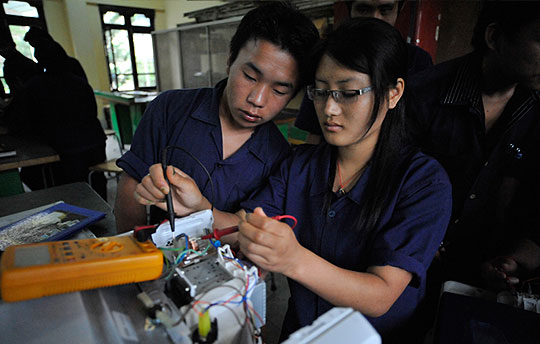Context: During Sri Lanka’s internal conflict, youth were often recruited, leading to 60 per cent of internally displaced persons being at or below age 30. As a result, these youth have often ended up lacking basic education making it difficult for them to secure decent work due to a lack of skills. While Technical and Vocational Education and Training (TVET) offers a potential solution to the issue, access is limited, particularly for disadvantaged youth.
Implementation of programme/ initiative: Sri Lanka’s National Strategy on TVET Provision for Vulnerable People seeks to address access issues related to TVET. Created in 2010, the Strategy aims to improve the skill sets of disadvantaged youth, persons affected by conflict, persons with disabilities, disadvantaged women, migrants and the poor. Furthermore, the Strategy specifically targets school drop-outs, former child labourers, internally displaced persons, ex-combatants and persons with mental and physical disabilities. Low education levels frequently prevent disadvantaged youth from applying for mainstream TVET, thus the Strategy focuses on providing flexible entry TVET that waives the requirement for formal education credentials.
Main challenges: Challenges include the geographic location of disadvantaged youth, which the Strategy has largely remedied by expanding coverage into rural areas. Scarce resources have also been an issue, thus the Strategy has called for the cooperation between vulnerable youth training centres, mainstream TVET centres and NGOs. Recognition of the skills youth obtain through TVET has been another challenge; this has been resolved by incorporating nationally accredited certificates into the programmes.
Results achieved: As a result of the National Strategy, three programmes dedicated to empowering disadvantaged youth have been established at vocational training centres in both urban and rural areas. The programmes have incorporated alternative training modes including apprenticeships, entrepreneurship mentorships and computer based training. Over 15 per cent of youth participants in the vocational training courses have benefited by receiving support to start or further develop their own micro-enterprise. For youth living in plantation areas, a subsistence allowance has been provided to encourage them to partake in the training courses, which have offered immediate employment upon completion.
Moving Forward: Vital to the continued success of the National Strategy is consistent monitoring and evaluation of its programmes. This includes generating timely statistics regarding the costs and outputs of programmes, along with systematic reviews of labour market demand. Courses offered need to be regularly updated based on the aforementioned evaluations so as to stay relevant, financially sustainable, and ensure that the skills taught are applicable to current labour market conditions.
Replicability: In whatever setting, systems need to be in place to effectively identify at risk or vulnerable youth to make better use of their potential. This can be achieved through legislation that targets vulnerable youth and provides them with the resources to be productive members of society. In Sri Lanka, this has been accomplished through a national strategy that includes opportunities to finish secondary education for early school leavers and TVET courses that allow disadvantaged youth to enroll without formal academic credentials.
References:
ILO, “National Strategy on TVET Provision For Vulnerable People in Sri Lanka, Strategies and Action Plans,” (Colombo: ILO, 2010), available from: http://apskills.ilo.org/resources/national-strategy-on-technical-and-vocational-education-and-training-provision-for-vulnerable-people-in-sri-lanka
UNESCO-UNEVOC, “World TVET Database Sri Lanka,” (Bonn: UNESCO-UNEVOC, 2012), available from: http://www.unevoc.unesco.org/wtdb/worldtvetdatabase_lka_en.pdf
Tertiary and Vocational Education Commission Ministry of Youth Affairs and Skills Development, “National Strategy on Technical and Vocational Education and Training Provision for Vulnerable People in Sri Lanka,” (Colombo: Government of Sri Lanka, 2010), available from: http://www.tvec.gov.lk/pr/TVET_Policies.htm
Project Details
Date: September 26, 2016
